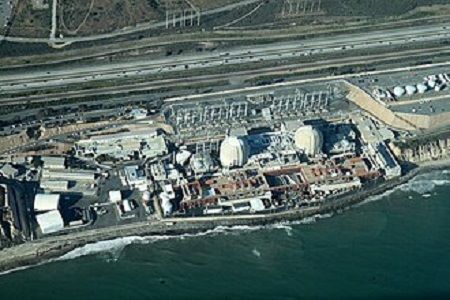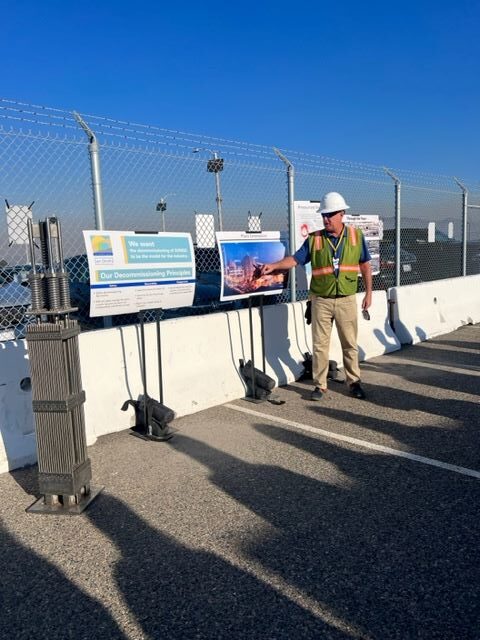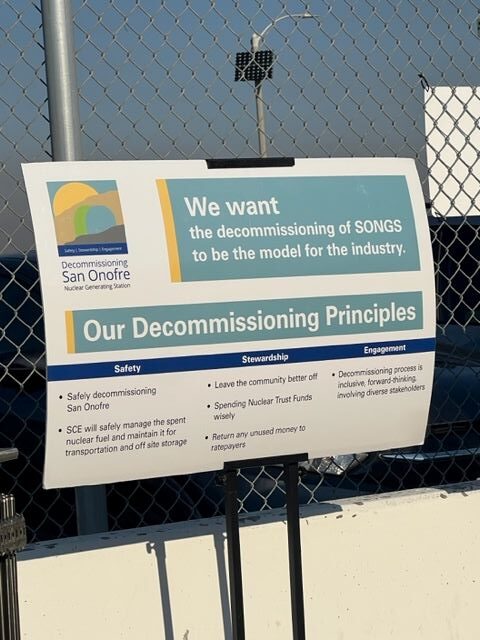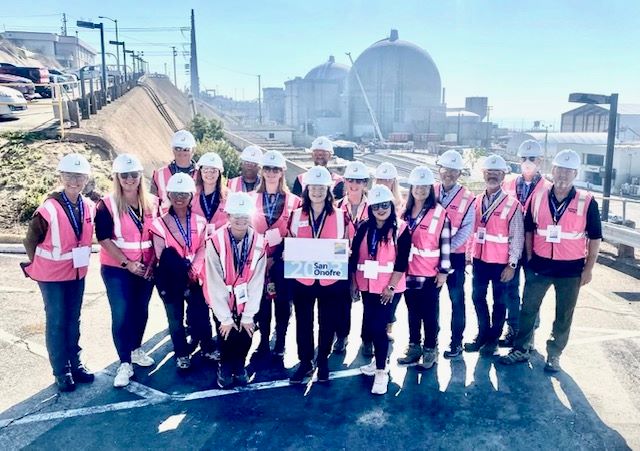By TR Robertson
The monthly Vista Chamber of Commerce Government Affairs Committee Meeting for November was a little different this month thanks to Vista Chamber CEO Rachel Beld. Beld arranged for a guided tour and presentation about the San Onofre Nuclear Generating Station and the ongoing decommissioning of the facility. An early morning 35-minute drive up Highway 5 to the Basilone Road turn off and a short drive along the beach route led to the entrance to the San Onofre SCE Parking Lot 4. Those attending the tour had been given instructions for access to the tour including valid identification, closed toe, safe, and sturdy shoes, long pants and shirts with sleeves. After checking in we were given badges with our names printed on them hanging on a lanyard, orange vests identifying us as on a tour, safety glasses and hard hats.

At 8:30 we received a short introduction to our tour guides, former employees of Edison who had worked at the nuclear plant when it was operational, and we were divided into two groups of about 10 or 12 each. Our guide was Mark Lewis, a graduate of SDSU in radiation physics, who was hired right out of college in 1982 to work at San Onofre. He has worked for Edison since then and has been leading tours for the past 7 years. One interesting fact about Mark is that he is a 27-year member of the Moonlight Amphitheatre orchestra playing trombone. Mark began his presentation by going over some ground rules for the 2-hour tour, indicating what we will be seeing and then filling in a bit of history of the San Onofre Nuclear Generating Station.

Unit 1 at San Onofre came online in 1968, one of the first in the U.S., and remained online until 1992 when it was decommissioned and removed. The site where Unit 1 was located is now the site for the spent nuclear fuel assembly’s storage area. Once San Onofre’s two containment buildings and other structures are removed the spent nuclear fuel dry storage will be all that remains of the San Onofre site. Unit 2 came online in 1983 and Unit 3 in 1984. San Onofre was once able to provide power to 1.4 million homes and businesses in California. SDG&E put up 20% of the cost for construction of the nuclear generating station and received 20% of the electrical output. The nuclear generating station stayed online until 2012 when operations were closed. There are currently 54 nuclear power stations in operation in the U.S., 10 plants that have been decommissioned and 20 plants in various stages of decommissioning.

The $4 billion dollar deconstruction process and removal of structures and rubble began at San Onofre about 3 years ago. There were many reasons for the shutting down of San Onofre – political environmental issues, reactions of anti-nuclear groups, but perhaps the #1 reason was the failure of one of the steam generators in the containment building and the extreme cost for replacement, estimated at $1 billion. When the plant was operational San Onofre employed between 1,800-2,200 people. The initial layoff when the plant shut down was 1,500 employees. Currently 200 Edison employees remain at San Onofre along with hundreds of contracted workers for various stages of the removal of structures and debris. Mark said ½ of the power plant has been removed so far.
We were given a quick explanation about how the nuclear generating station produced electricity when it was operational. One of the sections of the nuclear fuel assembly was on display, standing about 5 feet tall. The full fuel assembly unit 15 feet tall and contains 150 rods in each assembly. The fuel storage area will soon house 3,000 of these spent fuel assemblies. In the Pressurized Water Reactor these nuclear fuel assemblies are used for 3 years. The central rods start the fission process as the water is heated to 600 degrees. The water is turned into steam and the steam pumped to the turbine room. The steam turns the turbine which generates electricity that travels to the switchyard which then goes out to the customers. Along with this ocean water is used through a looping process to condense the steam in the turbine room back into water.

At another stop along the pathway of our tour, we saw an overview of Units 2 & 3 and the nuclear fuel assembly dry storage area. Units 2 & 3 are each 140 feet tall made of 8-foot-thick concrete designed round, which we were told is the most efficient shape for the structures. We were also told that when built thousands of seismic detectors were throughout the nuclear generating station. Mark then explained what the large train transport cars are taking away from San Onofre and later explained the different types of radiation. Some of the specially designed railroad cars take low grade spent fuel to Clive, Utah, and other railroad cars haul a variety of rubble and debris from the generating plant tear-down. There is some recycle material that is taken to Andrews, Texas. As far as radiation, we were shown how low-grade radiation is in many of the items we might have in our homes, such as antique glassware, a Coleman lantern replacement bag or a clock with luminous dials. He said even bananas show low grade radiation when subjected to testing.
On our way back to the starting point of our tour we stopped to look out over the nuclear spent fuel dry storage area. There are currently 75 dry storage cylinders units that hold the 20-foot-tall 28,000 lb. cylinders. The storage area is in 23-foot-thick concrete units each covered by a 30,000 lb. steel concrete lids. There is additional room for more of the storage units. The Federal government was obligated to provide storage areas for spent nuclear fuel, but that has been lost in a quagmire of legal issues. Yuca Mountain in Nevada was developed as a containment storage area but that has become a political ballgame with no end in sight.
Mark answered any questions the group had. He pointed out that San Onofre had done studies on the water released into the ocean that was used in some of the processes along the way and had brought in people that had backgrounds in oceanography and other fields that might be concerned with the effects the water release would have on ocean life. He said one effect was the increase in fish and seals in the area and fishing boats that pulled into the area. One noticeable change was the amount of kelp decreasing where the water was dispersed. Mark said they did bring in a company that helped build an artificial reef off the coast using concrete telephone poles and this was a success.
This tour of San Onofre Nuclear Generating Station and the decommissioning process is well worth taking. It is educational, informative and answers many questions you may have about what is happening at the site. The tour also answers many of the urban legends that have cropped up about what is going on with the spent nuclear fuel. If you or your group is interested on going on a tour, go to www.songscommunity.com and click on the link to sign up for a tour.
Are you interested in connecting your business with all levels of government? Our members stay in the know with the government affairs committee. Register for next month’s meeting: https://ow.ly/fEhH50Q3GFS




